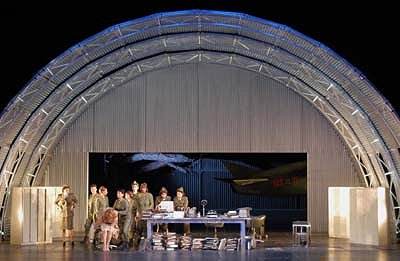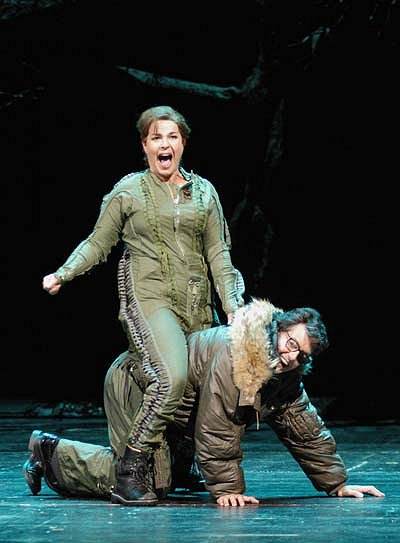|
Seen and Heard International Opera Review
Wagner:
Die Walküre,
Hessisches Staatstheater Wiesbaden, Premiere
on June 27, 2004 (SM)
Conductor:
Toshiyuki Kamioka
Director: John Dew
Sets: Peter Schulz
Costumes: Jose-Manuel Vazquez
Siegmund: Alfons Eberz
Hunding: Christoph Stephinger
Wotan: Ralf Lukas
Bruennhilde: Barbara Schneider-Hofstetter
Fricka: Gabriela Kuenzler
Valkyries: Annette Luig, Oxana Botscharova,
Thora Einarsdottir, Jelena Bodrazic, Gabriela
Kuenzler, Martina Langenbucher, Emma Foster,
Sandra Firrincieli
Tacky
wallpaper seems to be very much en vogue in
Wagner opera at the moment, as do dank and
dingy kitchens. First, there was Anna Viebrock's
stage design for Jossi Wieler's and Sergio
Morabito's superb "Siegfried" in the ground-breaking
Stuttgart "Ring" a few years ago. That was
Wagner as real kitchen-sink drama, complete
with rising damp, mouldy tea-towels, and a
grubby apron for Mime. Similar floral and
paisley-patterned wallpaper put in a brief
appearance in David Alden's wilful Munich
Ring last year. And it even found its way
into Bayreuth, in Claus Guth's striking "Hollaender".
John Dew's new "Walküre" which opened
at the Hessisches Staatstheater in Wiesbaden
on Sunday uses garish wallpaper again, this
time in faded 70s chic, all treacly browns
and oranges, in Hunding's hut in Act I. And
there's a drab kitchen complete with mildewed
fridge and clogged-up extractor hood to boot.
In fact, Dew and his stage designer, Peter
Schulz, seem to have come up with very similar
ideas to other recent Ring productions --
the paratrooping Valkyries of Juergen Flimm's
Bayreuth, being aired for the last time this
year; and the snow blizzards and army fatigues
of Robert Carsen's recently completed Cologne
cycle. Like Flimm, Dew casts Wotan (at least
in his scene with Fricka) as a powerful corporate
boss, complete with expensive suit and sleek
chrome and black leather office. And he also
gives a nod in the direction of Carsen's view
of the Ring as an environmental drama about
mankind's squandering of the earth's resources
and the degradation of the planet into a huge
ecological waste bin.

That is not to suggest that Dew is merely
a copycat, magpie collector of other people's
ideas. The New York-born director, who already
staged a complete cycle in Krefeld/Moenchengladbach
in 1981-1985, offers plenty of new takes and
perceptive insights of his own in his new
Ring-in-the-making in Wiesbaden. In "Rheingold",
Loge is Einstein and Valhalla a nuclear power
plant. Dew takes up the theme again in "Walküre",
when he casts Siegmund as an anti-nuclear
demonstrator complete with straggly hippy
hair and CND T-shirt on the run from the riot
police, of which Hunding is a member. No doubt
the nuclear motif will be continued and developed
in the subsequent parts ("Siegfried is due
in November and "Götterdämmerung"
some time next year).
As for the Ride of the Valkyries, there is
no Ride at all. The action takes place in
a vast aircraft hangar in which some of the
Valkyries are wartime air-traffic controllers
calling out orders through radio microphones
or sorting through the files of the names
of the dead warriors, while others stride
in, in full jumpsuits, flinging down their
report sheets before cracking open a bottle
of beer.
The scene generated much tutting and shaking
of heads among the first-night audience and
was undoubtedly the main reason for the booing
when the production team took their bows at
the end of the evening. But at least it steered
clear of some of the unintentionally comic
corpse-lugging frequently seen elsewhere.
And there was some gentle tongue-in-cheek
self-irony, too, as some of the Valkyries
camped it up in front of the microphones.
Perhaps the main strength of Dew's new "Walküre"
lies in his portrayal of the different dysfunctional
relationships of the main characters. Ute
Doering is a nimble and light-voiced Sieglinde,
who dares once or twice to just about hold
the gaze of Christoph Stephinger's gruff bulldog
of a Hunding in Act I, but is suitably harassed
and terror-stricken during the lovers' subsequent
flight. Gabriela Kuenzler was an admirable
Fricka, even if her mezzo did not always sit
comfortably as estranged husband and wife
wrestled over the remains of their loveless
marriage.
The pairing of Sieglinde and Siegmund was
weakened by the casting of Alfons Eberz as
Siegmund. Eberz appears to believe he's already
the bumbling and oafish Siegfried rather that
the fate-stricken Siegmund burning with incestuous
passion for his twin sister. His acting is
as one-dimensional as his singing, and he
spends much of the time stumbling or sitting
around on stage, open-mouthed and flummoxed
as to what's going on around him. His diction
was frequently unclear, his tone often inflexible.
By contrast, Wotan and Brünnhilde were
the stars of the show, carefully drawn and
lovingly played by Ralf Lukas and Barbara
Schneider-Hofstetter. Father and daughter
are inseparable from the very beginning, Wotan
pulling all the strings, conjuring up Hunding's
hut with a wave of his hand, and both watching
conspiratorily from behind the trunk of the
Weltesche as the lovers' drama unfolds. They
horse around like big kids at the beginning
of in Act II. Brünnhilde hangs on Wotan's
every word, her face beaming with love and
admiration. And that devotion is returned
by Wotan.
Lukas
and Schneider-Hofstetter are so completely
absorbed and absorbing that they have no need
for stage props or scenery in their final
farewell scene, which Dew reduces to a dark
stage, empty except for the even darker shadow
of the Weltesche looming in the background.
Schneider-Hofstetter
was making her role debut and what a warm,
humane soprano she has, full and firm in tone,
but with lots of different shading. Let's
hope she'll also be the Brünnhilde in
the next two parts of Dew's Ring. Lukas, too,
went from strength to strength, convincingly
catching the god's plight, arrogantly swaggering
on the one hand, weak and fumbling on the
other, ever flexible, always pleasing in tone.
Finally, in the pit, Wiesbaden's departing
general music director, Toshiyuki Kamioka,
was a phenomenon. Small and wiry, he noisily
jumped up and down, huffing and puffing for
all his worth, and the Hessisches Staatsorchester
played as if its life depended on it, even
if some of the edges were a little rough.
Simon
Morgan

Back to the Top
Back
to the Index Page
|



